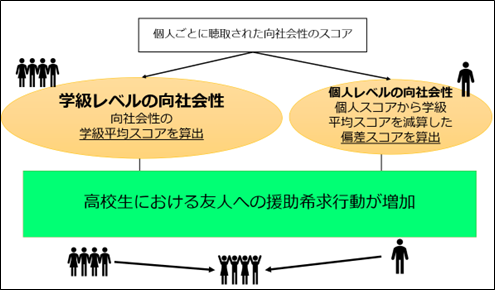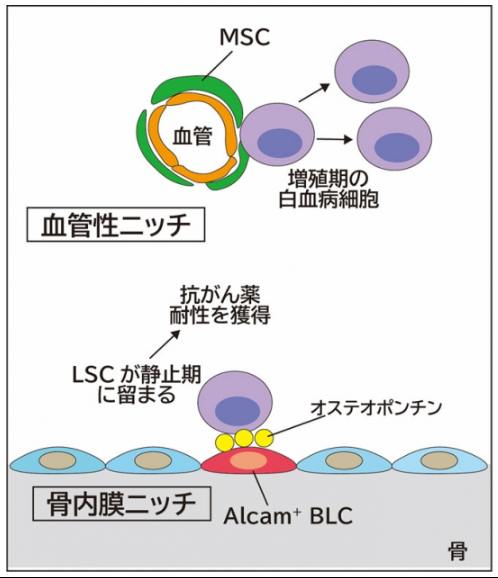2025-05-16 東京大学

所属する学級および個人レベルの向社会性と援助希求行動の関連を分析
<関連情報>
- https://www.h.u-tokyo.ac.jp/participants/research/saishinkenkyu/20250516.html
- https://www.h.u-tokyo.ac.jp/participants/research/saishinkenkyu/__icsFiles/afieldfile/2025/05/16/release_20250516.pdf
- https://jamanetwork.com/journals/jamanetworkopen/fullarticle/2834120
青少年における教室レベルおよび個人レベルの向社会性と助けを求める行動 Classroom-Level and Individual-Level Prosociality and Help-Seeking Behaviors Among Adolescents
Ryo Morishima, PhD; Satoshi Usami, PhD; Akiko Kanehara, PhD, MPH; et al
JAMA Network Open Published:May 15, 2025
DOI:10.1001/jamanetworkopen.2025.10319
Key Points
Question Can the association between prosociality and help-seeking behaviors among students be partially explained by classroom effects?
Findings In this cross-sectional study of 21 845 students, annual surveys conducted via questionnaire in Japanese junior and senior high schools revealed that both classroom-level and individual-level prosociality were associated with higher rates of help-seeking from friends among senior high school students. This association remained significant after controlling for individual characteristics, such as general psychopathology, and despite experiences of being bullied.
Meaning This finding suggests that a prosocial classroom climate in senior high school may facilitate help-seeking from peers, regardless of individual student characteristics.
Abstract
Importance Although individual prosociality, defined as voluntary behavior intended to benefit another, is known to promote help-seeking behaviors among adolescents, it remains unclear whether a prosocial community, such as the classroom, also facilitates these behaviors.
Objective To investigate the associations of classroom-level and individual-level prosociality with help-seeking behaviors, considering age and gender, and to examine moderation effects of being bullied.
Design, Setting, and Participants In this cross-sectional study, annual surveys were conducted via questionnaire among students in Japanese junior and senior high schools from 2020 to 2023. The first wave was administered from October 1 to November 7, 2020, followed by the second wave from June 4 to July 13, 2021, the third wave from June 17 to July 19, 2022, and the fourth wave from June 19 to July 28, 2023.
Exposure Classroom-level prosociality was defined as the mean prosociality of all students within a classroom, while individual-level prosociality was measured as the deviation from this classroom mean. Prosociality was assessed using the prosocial subscale of the self-reported Strengths and Difficulties Questionnaire.
Main Outcomes and Measures Generalized mixed-effects models estimated the associations of classroom-level and individual-level prosociality with help-seeking behaviors (including poor help-seeking and seeking help from friends, family members, homeroom teachers, and physicians) while considering subgroups based on grades and gender, as well as the moderation effect of being bullied. Help-seeking behaviors were evaluated by a question about seeking help for one’s mental health problems (“Are you currently consulting anyone to discuss your psychological stress or mental health problems?”), with multiple options. The robustness of the main findings were tested by models stratified by survey year.
Results The analysis included 21 845 participants (mean [SD] school grade, 10.4 [1.2]; 16.6% junior high school students and 83.4% senior high school students; 53.3% boys). Classroom-level prosociality was associated with a higher rate of help-seeking from friends among senior high school students (odds ratio [OR], 1.26, 95% CI, 1.17-1.35), which confirmed the robustness. No moderation effect of being bullied was found in this association. Higher individual-level prosociality was associated with increased help-seeking from various sources across nearly all models and subgroups, regardless of being bullied (friends: OR, 1.15 [95% CI, 1.13-1.17]; P < .001; family members: OR, 1.09 [95% CI, 1.07-1.11]; P < .001; homeroom teachers: OR, 1.15 [95% CI, 1.10-1.19]; P < .001; school nurses: OR, 1.19 [95% CI, 1.12-1.28]; P < .001; and physicians: OR, 1.14 [95% CI, 1.07-1.20]; P < .001).
Conclusions and Relevance This cross-sectional study of 21 845 students found that both classroom-level and individual-level prosociality were associated with higher rates of help-seeking from peers among senior high school students, while accounting for individual characteristics. Enhancing classroom prosociality could foster help-seeking behaviors through reciprocal peer support, benefiting even those who experienced bullying.


